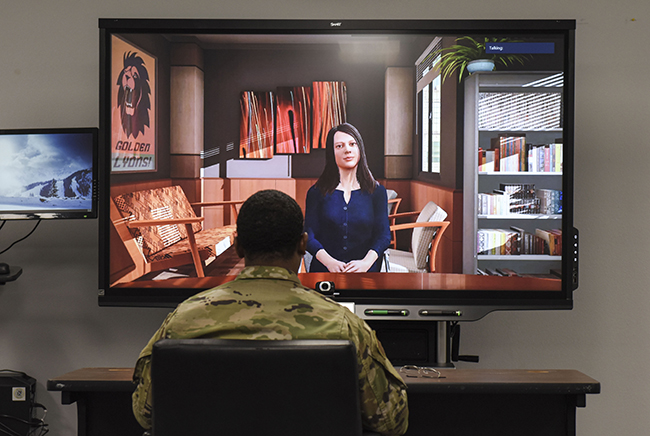
A Basic Instructor Course student, center, participates in a immersive counseling simulation session to practice academic counseling techniques on an artificial intelligence avatar at Sheppard AFB, Texas, on Aug. 8, 2019. Air Force photo by SrA. Ilyana Escalona.
The Air Force on Sept. 12 published an artificial-intelligence strategy recognizing that, to take full advantage of data-crunching algorithms, the service must modernize the technology airmen use to do their jobs every day. One expert says that commitment doesn’t go far enough.
The strategy, an annex of the Defense Department’s own AI plan, lays out five focus areas to help the Air Force move through a process that will lead it to daily operational use of self-learning software. That includes digitizing its daily workflows, cleaning the data that is created, embracing the commercial sector to quickly develop and buy technology that uses the data, sharing the data with all who need it, and training people to use AI effectively and ethically.
If executed correctly, the strategy envisions an Air Force that moves away from whiteboards and manual input to make everyday tasks more manageable and combat decisions faster. It also notes that the service must harden its defenses against adversaries’ own AI.
“AI has already proliferated into many commercial enterprises and, as such, cannot be governmentally controlled or contained,” the document states. “Just as the commercial sector has rushed to embrace these technologies, our global competitors are overtly accelerating the integration and weaponization of AI as an effective measure to counter our traditional strengths and exploit our perceived weaknesses.”
Building proficiency in computer programming languages, as well as the “cultural adoption of emerging technologies,” remains the biggest hurdle of the information age, officials say.
“We will continue to develop our workforce by providing dynamic, non-traditional, and technologically contemporary career opportunities in an aim to attract, cultivate, and best manage our people, who will always be our greatest asset,” the strategy states. “AI is not a means to replace people.”
The strategy, signed by Chief of Staff Gen. David Goldfein and Acting Secretary Matt Donovan, will drive future budget proposals and project selection. A separate appendix offers a framework for AI prioritization and prototyping. Overall, the document aligns the Air Force with AI efforts across the Pentagon, including those led by the Joint Artificial Intelligence Center and the Air Force’s own AI cross-functional team.
“Artificial intelligence is not the solution to every problem. Its adoption must be thoughtfully considered in accordance with our ethical, moral, and legal obligations to the nation,” the document said. “As stewards of this great responsibility, airmen should execute their assigned missions with a focus on emerging technologies, but also with an understanding that everything we do is a human endeavor.”
Lindsey Sheppard, an associate fellow at the Center for Strategic and International Studies, wrote Sept. 13 that the strategy is notable for its embrace of open-source software.
“For several years, open-source software faced skeptical audiences in DOD and the service branches as these communities often equate classified and sole-source as secure and invaluable,” Sheppard wrote. “By contrast, open-source code is a foundation of software development, particularly in AI and machine learning. The strategy’s objectives to utilize open-source software and algorithms support the adoption of both AI technology and software-driven capability throughout the enterprise.”
But, she argues, the strategy doesn’t commit strongly enough to information technology modernization. That refresh should be on par with the service’s focus on data.
“As the JEDI cloud-computing contract continues without a decision amid questions surrounding conflicts of interest, DOD may unintentionally incentivize the services to pursue their own bespoke computing solutions,” Sheppard wrote. “Regardless of a multi-cloud or single-cloud solution, strategic guidance is necessary for bringing an enterprise computing capability to DOD and the services.”
Earlier this year, the service also published a “Digital Air Force” plan along the same lines. Rather than rely on stovepiped computer systems that can’t share information, Air Force Magazine previously reported, the service will work to make data more shareable and accessible, rely more heavily on cloud-based servers, and prioritize resilient cybersecurity.
“We must synergize three interconnected and mutually supporting reform efforts: IT architecture, data management, and business operations reform,” according to a July 9 white paper. “Every segment of the Air Force will be impacted by these changes: we are driving to integrate warfighting, information operations, cyber, and business practices as a vehicle for dominating great-power competition.”
This is the newest frontier of military technology, the Air Force said: “AI is no longer limited to science fiction.”